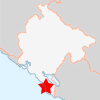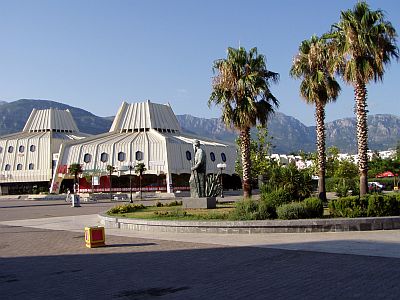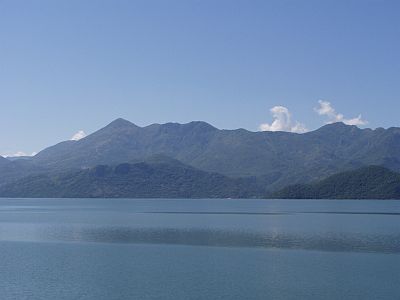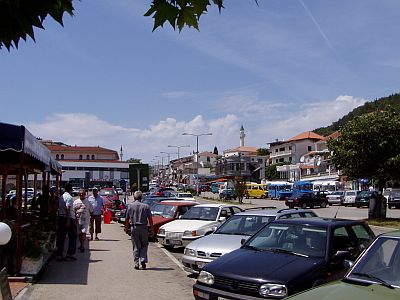Official Name
Бар (Bar). There aren't many place names on this planet that are easier to remember then this one. Italians call the town Antivari, which simply means "opposite of Bari" - the large Italian town on the other side of the Adriatic Sea. There are more towns in Europe called Bar, but this town is the biggest of them. Bar today refers to the new town right at the coast. The old town of Bar lies some kilometres away away from the coast and is, logically, called Стари Бар (Stari Bar, Old Bar). Another name that occasionally appears in historic documents is Antipargal.
Location

| ||
| Location of Bar |
Bar lies in the Southwest of small Montenegro on a small bay at the Adriatic Sea. Behind the town starts the small Rumija Mountain Range with up to 1,595 metre high mountains. Large parts of the mountains - though not the part near Bar - are covered with forests. The mountain range separates the Adriatic Sea from the large Lake Shkodra (aka Lake Skutari, see below). They stretch all the way to the border with →Albania. The Montenegrin capital Podgorica is some 50 km away, →Belgrade around 500 km.
Population
About 25,000 inhabitants. The district with the same name has around 45,000 inhabitants. Add several ten thousands of visitors in summer - Bar is a popular spa.
Orientation
 | ||
| Main Square of Bar |
As already mentioned above, Old Bar and (New) Bar are quite far away from each other. The old town lies northeast of the main coastal road, the new town southwest of it. The latter is not very big. The central square with its oddly shaped concrete huts in the middle can't be missed. The main road, crossing the central square, is only a few blocks away from the beach. The train station is around 1.5 kilometres away from the centre.
Halfway between the train station and the centre lies the bus terminal. The large port is a little bit further away but can be easily seen from the beach. The new Bar itself is not overwhelmingly attractive, but the parks along the beach make up for a nice walk. The old town is towering on a large bald hill at the foot of the Rumija mountains. Old Bar is around 5 km away from Bar, so it takes an hour or so to walk there.
History
Bar is only one of many historic towns along the Montenegrin coast (and Dalmatian coast). A Roman fortress called Antipargal was first mentioned in the 6th century AD. The construction of the fortress probably marked the beginning of the town. However, Bar as it is known today is some kilometres away from the original location. In the 10th century, the new name Antibar (=opposite Bari) appeared in maps of the area.
Bar changed hand several times - Venetians, Ottomans and Slavs alternally conquered the town or the entire region respectively. For more information, see →Kotor. Bar also became the seat of the Archbishop. It was only in 1878 that the town fell under Montenegrin rule. In 1913, Bar was connected to the railroad network. Today, the town is home to Montenegro's only important port. Additionally, Bar and the area around it is a very popular spa and tourist destination for Serbs and Montenegrins in summer - but there are also more and more foreign tourists heading for Bar.
Getting there / transportation
There are several ways to get to Bari. Frequent ferries run from Bar to Bari (9 hrs) and Ancona in Italy, →Kotor and also along the Dalmatian coast to →Croatia and →Slovenia.
Bar is the final stop on the railroad connecting →Belgrad with the Adriatic coast. There are two daily trains to →Belgrad and some more passing Belgrade, running via →Novi Sad to Subotica in Northern Serbia. All of those trains also stop in Podgorica (around 1 hour). The whole way to Belgrade takes around 8½ hours. Note that those trains are often completely booked out in summer. In that case, you may need to resort to a 1st class ticket, which costs € 21.20 (as of 2005).
Bar is also an important hub for buses and microbuses running virtually everywhere - except for →Albania. Travelers heading for Albania need to change the bus in either Ulcinj or Podgorica. The microbus to Ulcinj (see below) costs € 2. Almost all larger destinations in Montenegro can be reached by bus from Bar. A private company runs a bus line between Bar and the Old Bar. Bus stops can be easily found. The fare is € 0.50 Euro, to be paid on the bus.
Apart from a splendid small castle at the beach promenade and the strange main square entirely made of concrete, there is not much to see in Bar. It's a typical summer spa with a gravel beach and countless visitors during the warm season. Of course there are also many bars and restaurants catering the crowd. So Bar itself is not necessarily a must-see, but nearby Стари Бар (Stari Bar, Old Bar) at the foot of the mountains definitely is.

| ||
| The marvellous ruins of Old-Bar |
Same as →Kotor, some dozen kilometres away from Bar, Old Bar was almost completely leveled by a strong earthquake in 1979. However, when looking at pictures of Old Bar before the temblor, the town was already quite deserted and dilapidated beforehand. But the earthquake barely left a building that could be inhabited any longer - everything collapsed. What's left is a fascinating ghost town, surrounded by a large wall, with the mountains in the back as the perfect setting. Entrance fee to the old town is € 1 today. One of the reasons why this place is so fascinating, might be the fact, that virtually nothing was done since the quake in wide parts of the town - nature is gradually taking it's place back between all the collapsed walls. Somehow, this place can be even described as romantic.

| ||
| Old Bar: Parts of the old were restaurated or are due to be restaurated |
But it's not that nothing was done at all - some buildings were rebuilt already, and the town is trying hard to bring it in shape again. The Adriatic Sea cannot be seen from Old Bar, but together with the massive rocks and mountains behind the town, Old Bar offers a unique scenery. The small lane leading to the entrance of the town is very nice, too: Half of the buildings are deserted, many of them collapsed, but it's still a lovely, typical Mediterranean atmosphere with laid-back inhabitants.
Since Bar is easy to reach from various destinations around Montenegro, it's the perfect place to start a tour through Montenegro. While the new town isn't very interesting, Old Bar is definitely a place that shouldn't be missed. Amazingly, even during the summer season, it's not much frequented - most visitors seem to prefer to stay at the beach. But I'm sure it's even more fascinating in winter.
Behind the Rumija Mountain Range, when looking from Bar, and only some 20 km away from the Adriatic Sea, lies the large Скадарско језеро (Skadarsko jezero), better known as Lake Shkodra aka Lake Skutari. The larger part of the Lake belongs to Montenegro, but the southern part is already territory of →Albania. Lake Shkodra is nothing less but the biggest lake on the Balkans - even larger then →Lake Ohrid and Lake Prespa in Macedonia/Albania/Greece.

| ||
| Bar: Lake Shkodra and the green Rumija mountains |
Lake Shkodra covers an area of 368 km², but in many places the lake is less then 10 meters deep - especially in the northern part. The lake is mainly fed by melting snow, which means that the water level is oscillating considerably. The almost 50 km long lake fills a huge karst field, which means that huge caves collapsed once to form a deep valley. At the southern tip of the lake lies the large Albanian town of →Shkodër.

| ||
| In the centre of Ulcinj |
Less then 20 km south of Bar is Montenegro's southernmost town, called Улцињ (Ulcinj), Albanian: Ulqin, in Italian also known as Dulcigno. The town has some 30,000 inhabitants and is therefore slightly larger - and also more vibrant - then Bar. The historic town of Ulcinj lies on a small hill overlooking the Adriatic Sea. Ulcinj has a very long history as well - and is popular with visitors in summer. There's a large Albanian minority - if not majority ? - in town, so many street signs and shop names are in Albanian. As a visitor, it's sometimes difficult to know which language to use (or better say try to use) - Serbian or Albanian.
There's no lack of accommodation, and even during the peak in summer it seems to be possible to get a decent place to sleep (at least I had no trouble in finding one when I arrived without reservation in July). Putnik Tours is a good place to head for - they offer decent private accomodation. Just walk towards the beach from the main square and turn right before you get to the beach. It's right there on the first floor. After some calls they offered me private accommodation right at the central square - for € 10 a night. Staff even brought me there by car although it wasn't even 500 m away. The phone number of Putnik Tours: Tel: 311-588; 311-605.
- www.bar.cg.yu Official and quite helpful website of the city of Bar - in English and Serbian (Latin letters).
Do you have or do you know a good website about Bar? Don't hesitate, let me know! After checking it, I would love to add it to the link list. You can submit a link by using the →contact form. Note that commercial websites will be treated differently.
©2024 Europe-East.com

 Albania
Albania Montenegro
Montenegro